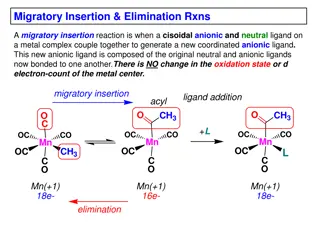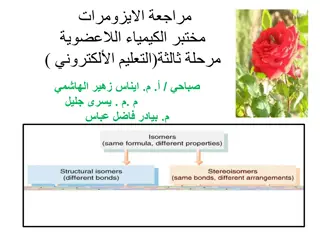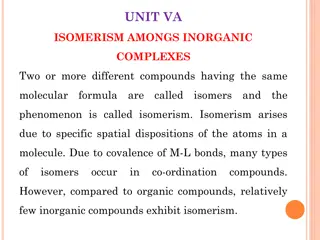Introduction to Creating Simplicial Complexes from Data
Learn how to create a simplicial complex from data points through a step-by-step process. Starting with 0-dimensional vertices and defining closeness between data points, progress to adding 1-dimensional edges. Ideal for those interested in topological data analysis across various fields.
Uploaded on Sep 29, 2024 | 1 Views
Download Presentation

Please find below an Image/Link to download the presentation.
The content on the website is provided AS IS for your information and personal use only. It may not be sold, licensed, or shared on other websites without obtaining consent from the author.If you encounter any issues during the download, it is possible that the publisher has removed the file from their server.
You are allowed to download the files provided on this website for personal or commercial use, subject to the condition that they are used lawfully. All files are the property of their respective owners.
The content on the website is provided AS IS for your information and personal use only. It may not be sold, licensed, or shared on other websites without obtaining consent from the author.
E N D
Presentation Transcript
Lecture 6: Creating a simplicial complex from data. in a series of preparatory lectures for the Fall 2013 online course MATH:7450 (22M:305) Topics in Topology: Scientific and Engineering Applications of Algebraic Topology Target Audience: Anyone interested in topological data analysis including graduate students, faculty, industrial researchers in bioinformatics, biology, business, computer science, cosmology, engineering, imaging, mathematics, neurology, physics, statistics, etc. Isabel K. Darcy Mathematics Department/Applied Mathematical & Computational Sciences University of Iowa http://www.math.uiowa.edu/~idarcy/AppliedTopology.html
Creating a simplicial complex Step 0.) Start by adding 0-dimensional vertices (0-simplices)
Creating a simplicial complex Step 0.) Start by adding data points = 0-dimensional vertices (0-simplices)
Creating a simplicial complex 0.) Start by adding 0-dimensional data points Note: we only need a definition of closeness between data points. The data points do not need to be actual points in Rn
Creating a simplicial complex (1, 8) (2, 7) (1, 5) 0.) Start by adding 0-dimensional data points Note: we only need a definition of closeness between data points. The data points do not need to be actual points in Rn
Creating a simplicial complex (dog, happy) (wolf, mirthful) (dog, content) 0.) Start by adding 0-dimensional data points Note: we only need a definition of closeness between data points. The data points do not need to be actual points in Rn
Creating a simplicial complex 1.) Adding 1-dimensional edges (1-simplices) Note: we only need a definition of closeness between data points. The data points do not need to be actual points in Rn
Creating a simplicial complex 1.) Adding 1-dimensional edges (1-simplices) Add an edge between data points that are close
Creating a simplicial complex 1.) Adding 1-dimensional edges (1-simplices) Add an edge between data points that are close
Creating a simplicial complex 1.) Adding 1-dimensional edges (1-simplices) Let T = Threshold Connect vertices v and w with an edge iff the distance between v and w is less than T
Creating a simplicial complex 1.) Adding 1-dimensional edges (1-simplices) Let T = Threshold = Connect vertices v and w with an edge iff the distance between v and w is less than T
Creating a simplicial complex 1.) Adding 1-dimensional edges (1-simplices) Add an edge between data points that are close
Creating the Vietoris-Rips simplicial complex 2.) Add all possible simplices of dimensional > 1.
Creating the Vietoris Rips simplicial complex 2.) Add all possible simplices of dimensional > 1.
Creating the Vietoris Rips simplicial complex Step 0.) Start by adding data points = 0-dimensional vertices (0-simplices)
Creating the Vietoris Rips simplicial complex 1.) Adding 1-dimensional edges (1-simplices) Add an edge between data points that are close
Creating the Vietoris Rips simplicial complex 2.) Add 2-dimensional triangles (2-simplices) Add all possible 2-simplices.
Creating the Vietoris Rips simplicial complex 3.) Add 3-dimensional tetrahedrons (3-simplices) Add all possible 3-simplices.
Creating the Vietoris Rips simplicial complex 4.) Add 4-simplices Add all possible 4-simplices.
Creating the Vietoris Rips simplicial complex Step 0.) Start by adding data points = 0-dimensional vertices (0-simplices)
Creating the Vietoris Rips simplicial complex 1.) Adding 1-dimensional edges (1-simplices) Add an edge between data points that are close
Creating the Vietoris Rips simplicial complex 2.) Add all possible simplices of dimensional > 1.
Creating the Vietoris Rips simplicial complex Let T = Threshold = Connect vertices v and w with an edge iff the distance between v and w is less than T
Creating the Vietoris Rips simplicial complex 0.) Start by adding 0-dimensional data points Note: we only need a definition of closeness between data points. The data points do not need to be actual points in Rn
Creating the Vietoris Rips simplicial complex 0.) Start by adding 0-dimensional data points Note: we only need a definition of closeness between data points. The data points do not need to be actual points in Rn
Topology and Data. Gunnar Carlsson www.ams.org/journals/bull/2009-46-02/S0273-0979-09-01249-X
Vertices = Regions of Interest Create Rips complex by growing epsilon balls (i.e. decreasing threshold) where distance between two vertices is given by where fi = measurement at location i
Your name homology 3 ingredients: 1.) Objects 2.) Grading 3.) Boundary map n : Cn Cn-1 such that 2 = 0
Counting number of connected components using homology v2 v5 e1 e2 e3 e4 v1 v3 v4 v6 e5 C0 = Z2[v1, v2, v3, v4, v5, v6] = set of 0-chains C1 = Z2[e1, e2, e3, e4, e5] = set of 1-chains
Counting number of connected components using homology v2 v5 e1 e2 e3 e4 v1 v3 v4 v6 e5
Counting number of connected components using homology v2 v5 e1 e2 e3 e4 v1 v3 v4 v6 e5 o(e1) = v1 + v2 o(e2) = v2 + v3 Components are {v1, v2, v3} and o(e3) = v4 + v5 {v4, v5, v6} o(e4) = v5 + v6 o(e5) = v4 + v6
Counting number of connected components using homology v2 v5 e1 e2 e3 e4 v1 v3 v4 v6 e5 C0 = Z2[v1, v2, v3, v4, v5, v6] = set of 0-chains C1 = Z2[e1, e2, e3, e4, e5] = set of 1-chains : C1 C0 o
Counting number of connected components using homology v2 v5 e1 e2 e3 e4 v1 v3 v4 v6 e5 : C1 C0 o o(e1) = v1 + v2 o(e2) = v2 + v3 o(e3) = v4 + v5 o(e4) = v5 + v6 o(e5) = v4 + v6
Counting number of connected components using homology v2 v5 e1 e2 e3 e4 v1 v3 v4 v6 e5 : C1 C0 o o(e1) = v1 + v2 o(e2) = v2 + v3 Extend linearly: o(e3) = v4 + v5 o(e4) = v5 + v6 o(e5) = v4 + v6
Counting number of connected components using homology v2 v5 e1 e2 e3 e4 v1 v3 v4 v6 e5 : C1 C0 o o(e1) = v1 + v2 o(e2) = v2 + v3 Extend linearly: o(e3) = v4 + v5 o(e4) = v5 + v6 o(e5) = v4 + v6
Counting number of connected components using homology v2 v5 e1 e2 e3 e4 v1 v3 v4 v6 e5 : C1 C0 o o(e1) = v1 + v2 o(e2) = v2 + v3 Extend linearly: o(e3) = v4 + v5 o(e4) = v5 + v6 o(e5) = v4 + v6
Counting number of connected components using homology v2 v5 e1 e2 e3 e4 v1 v3 v4 v6 e5 o0 o1 C1 C0 0 Z0 = kernal of = {x : (x) = 0} o0 o0
Counting number of connected components using homology v2 v5 e1 e2 e3 e4 v1 v3 v4 v6 e5 o0 o1 C1 C0 0 Z0 = kernal of = {x : (x) = 0} o0 o0 = C0 = Z2[v1, v2, v3, v4, v5, v6]
Counting number of connected components using homology v2 v5 e1 e2 e3 e4 v1 v3 v4 v6 e5 o(e1) = v1 + v2 o(e2) = v2 + v3 o0 o1 C1 C0 0 o(e3) = v4 + v5 Z0 = Z2[v1, v2, v3, v4, v5, v6] o(e4) = v5 + v6 o(e5) = v4 + v6 o1 B0 = image of
Counting number of connected components using homology v2 v5 e1 e2 e3 e4 v1 v3 v4 v6 e5 H0 = Z0/B0 = <v1, v2, v3, v4, v5, v6 :v1 + v2 = 0, v2 + v3 = 0, v4 + v5 = 0, v5 + v6 = 0, v4 + v6 = 0>
Counting number of connected components using homology v2 v5 e1 e2 e3 e4 v1 v3 v4 v6 e5 Z0/B0 = <v1, v2, v3, v4, v5, v6 : v1 + v2 = 0, v2 + v3 = 0, v4 + v5 = 0, v5 + v6 = 0, v4 + v6 = 0>























